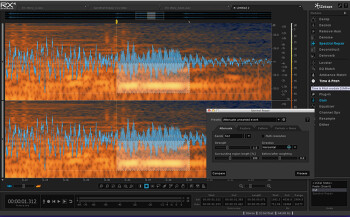There’s no such thing as magic, but after using some of today’s amazingly powerful DSP software, it sometimes seems like there is. One product that definitely has the magic touch is iZotope RX, an audio restoration suite that just came out with its fourth major revision, RX 4, which introduces some cool new features. In this article, though, we’re going to look at how to use one of the RX modules that’s been around since the very first version: Spectral Repair, which gives you processing abilities you can't find anywhere else.
For those unfamiliar, RX is a stereo editor that features numerous processor modules that you can bring to bear on noises, clicks, pops and other audio glitches to remove them in a natural sounding way. The basic version of RX gives you the aforementioned Spectral Repair, as well as modules like Time & Pitch, Denoise, Remove Hum, EQ, Declick, among others, and RX Advanced, a more expensive and deeper version, adds such modules as Dereverb, Deconstruct, Ambience Match, EQ Match, among others. For more about how RX works, read our review of RX 3 Advanced. Right here we’re going to talk about how to use one of the modules — Spectral Repair — which is available in both the basic and Advanced versions.
The spectre of Spectral Repair
When you find a stray noise on your recording, say a finger squeak on a guitar or bass part, or an external sound that got picked up as a note was sustaining, the first thing you need to do is to open the audio fine in RX, and then select the noise in RX’s display, which offers both waveform and spectrogram style readouts. You can viewed them both together, separately, or in any proportion between the two.
You’re further helped in your selection process by the myriad selection options available: You can make a standard time selection — zoomed down to the sample level if needed — or you can make a frequency and time selection, where you’re only selecting a frequency range within the time selection. If you do so, and you want to hear what you’ve selected, you can use the Play Frequency Selection button on the transport controls, and you’ll hear only the audio within your selection.
So if, for example you have a noise that is mostly in the high frequency range, you could select it (the Spectrogram makes it pretty easy to the glitchy parts of the audio) and process it without even touching the other frequencies around the selection.
Before or after you’ve made your selection, you need to open the Spectral Repair module from the list on the right, and choose one of its processes. There are four different possible processes to choose from, but I’m going to concentrate on two here: Attenuate and Replace. These two are super useful for music applications. Both use the process of interpolation, which looks at the audio surrounding the selection to determine how to change the selection to make it match. Attenuate lowers the level of a selected event to match it to the surrounding audio. Replace is usually better for areas that have no useful audio in them, and need to be replaced completely.
For a finger squeak, I usually start with Attenuate, which is easier to use, and see if it will take care of the problem. After selecting the glitch, I hit play with Loop Playback selected in the Transport menu, and it cycles my selection over and over, letting me hear if I’ve selected any tonal audio beyond the squeak. If so, I’ll make the selection smaller. It’s usually pretty easy to see a finger squeak in the display, because it’s waveform is frequently a lot denser looking (see graphic above).
Once you’re satisfied that you’ve isolated it correctly, hit the Process button to initiate the processing. If you don’t like it, just Undo it and change the settings or the selection boundaries. Frequently you have to experiment a little to get the result you want. It’s easy, just hit the keyboard shortcut for undo (Command + Z on Mac, Control + Z on Windows) and try adjusting the parameters a bit. Then process, listen, and undo and make additional adjustments if necessary. I usually start with the Strength parameter, which adjusts the amount of the effect and the Before/After Weighting, which tells RX to favor the audio on one side of the selected event or the other. You can also try doing multiple passes with Spectral Repair, which sometimes is the best strategy.
Here’s an example of a finger squeak in an acoustic guitar part.

Now here it is with the Attenuate process applied, using the default settings. I could also get a good result with Replace in this situation.

A tale of the tail
Another good music-related use of RX is to clean up a ring-out on a track where a stray noise mars an otherwise good take (see graphic below).
Listen for the click around two seconds into the example.

I first applied Replace, using its default settings, but there was still some of the noise left. Next I tried a pass of Attenuate, and that improved it substantially. Take a listen.

Over and out
This article gives you a sense for some of the possibilities of Spectral Repair. Although it’s just one of many modules in RX and RX Advanced, it’s a really powerful one, and has allowed me to salvage tracks that otherwise would have been unusable.
iZotope offers a 10-day free trial of either RX 4 or RX 4 Advanced, which you can download from its website, so you can try Spectral Repair (and the rest of the modules) out for yourself.


